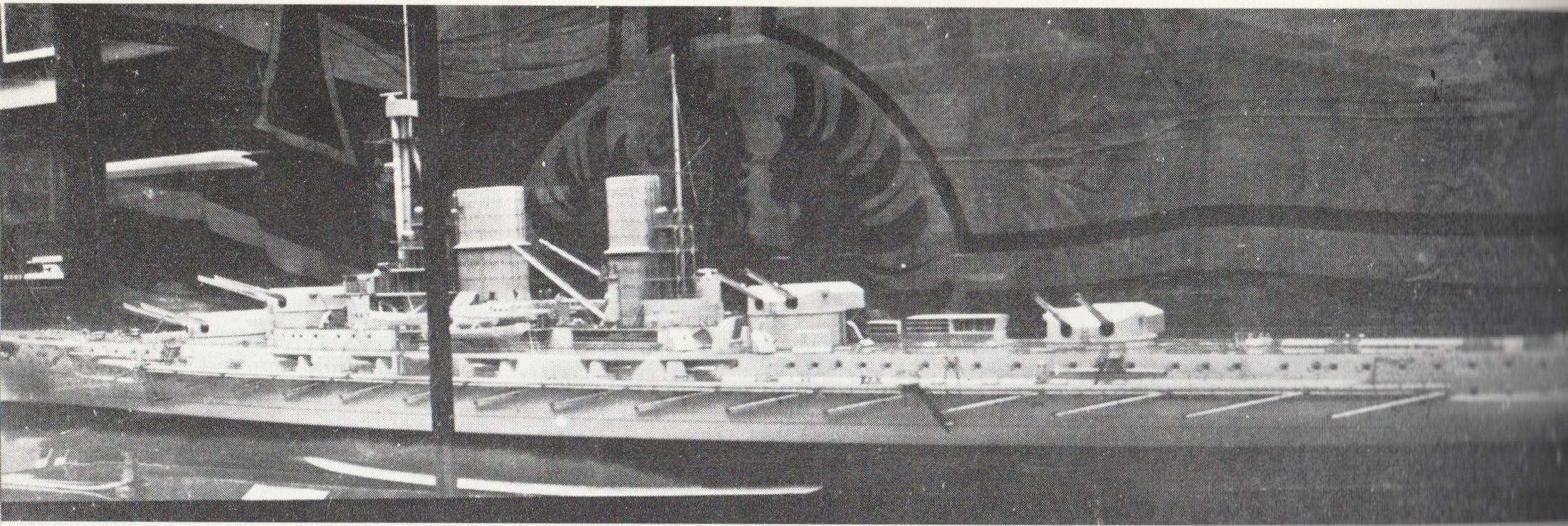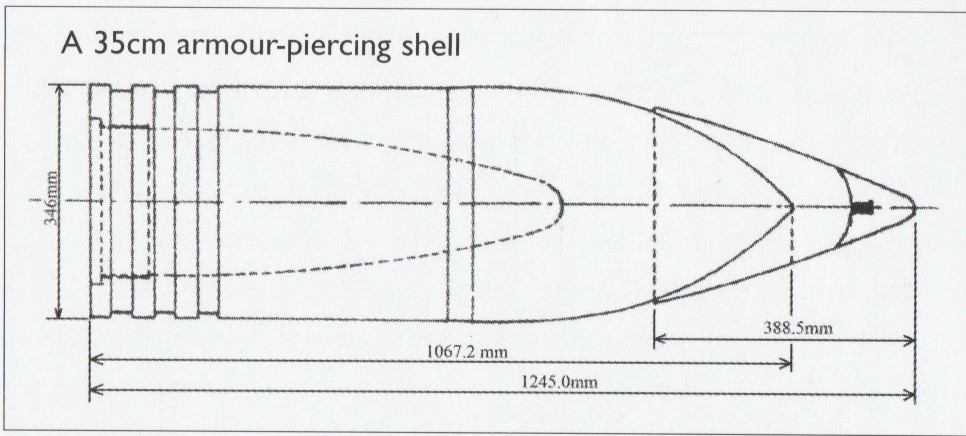
Planned for the never-completed Mackensen Class battlecruisers. Jackets from unfinished guns were used in building the long-range Paris Gun.
In 1922 there existed thirteen 35 cm SK L/45 guns, 15 naval gun carriages and 13 recoil mechanisms. Not all the series numbers of these guns were kept in the archives, but serial numbers 1 to 9 (the eight guns plus one spare intended for Mackensen) were destroyed at the Wilhelmshaven Arsenals as required by the terms of the Versailles Treaty.
The naval mountings for these guns were to use electric pumps to drive hydraulic elevation gear while the training was all electric. These guns also would have had hydraulically worked shell hoists, rammers and breeches.
Source note: Some sources claim that one of these guns was used at Flanders, but this seems to be a case of mistaken identity. Krupp built a special long-range 35.5 cm SK L/52.5 gun called "König August" which was completed in 1913. This gun was to be used at Calais if the Germans penetrated that far, but was instead used in semi-permanent fortress XII at Quéant in October 1916. It was later at Sancourt and fired at Doulles in 1918.
| Designation | 35 cm/45 (13.78") SK L/45 |
|---|---|
| Ship Class Used On | Mackensen Class |
| Date Of Design | 1914 |
| Date In Service | 1917 (as Field Artillery) |
| Gun Weight | about 162,000 lbs. (73,500 kg) 1 |
| Gun Length oa | 620.1 in (15.750 m) |
| Bore Length | 584.25 in (14.840 m) |
| Rifling Length | 487.0 in (12.369 m) |
| Grooves | (88 2) 0.138 in D x 0.327 in W at start narrowing to 0.268 in W at muzzle (3.5 mm D x 8.3 mm W to 6.8 mm W) |
| Lands | 0.165 in at start widening to 0.244 in at muzzle (4.2 mm to 5.7 mm) |
| Twist | Uniform RH 1 in 30 |
| Chamber Volume | 15,872 in3 (260 dm3) |
| Rate Of Fire | 2.5 rounds per minute |
| Type | Cartridge - Bag |
|---|---|
| Projectile Types and Weights 1a | APC L/3,6 - 1,323 lbs. (600 kg) 2a HE L/4,2 base fuze - 1,323 lbs. (600 kg) |
| Bursting Charge | APC - 44 lbs. (20 kg)
HE - about 88 lbs. (40 kg) |
| Projectile Length | APC - 49.0 in (124.5 cm)
HE - about 56 in (144 cm) |
| Propellant Charge 3a | Rear Charge - N/A
Fore Charge - N/A Brass case for rear charge - N/A |
| Muzzle Velocity | 2,756 fps (840 mps) |
| Working Pressure | 20.0 tons/in2 (3,150 kg/cm2) |
| Approximate Barrel Life | 250 rounds |
| Ammunition stowage per gun | 85 rounds |
- ^
Actual Naval Projectile designations APC L/3,6 35 cm Psgr. L/3,6 HE L/4,2 base fuze 35 cm Spr.gr. L/4,2 Bdz - ^A Note on Sources: Many English language references show the designation for the Psgr. (APC) projectile with a "(m.Hb)" suffix (projectile with ballistic cap). However, this suffix is not used in any German documentation for this projectile that I have found.
- ^These guns, like most large caliber German guns, used a "fore charge" which was propellant in a silk bag, and a "rear charge" which was propellant in a brass case. The brass case helped to seal the breech of the gun.
| Elevation | Distance |
|---|---|
| 16 degrees | about 21,870 yards (20,000 m) |
| 20 degrees | 25,800 yards (23,600 m) |
| 28 degrees | about 30,730 yards (28,100 m) |
| Designation | Two-gun Turrets 1b Mackensen (4): Drh L C/1914 Graf Spee and Fürst Bismarck (4): Drh L C/1915 |
|---|---|
| Weight | N/A |
| Elevation | -5 / +28.0 degrees 2b 3b |
| Elevation Rate | N/A |
| Train | Turrets A and B: +150 / -150 degrees
Turrets C and D: +155 / -155 degrees |
| Train Rate | N/A |
| Loading Angle | +2.5 degrees |
| Gun recoil | N/A |
- ^Each gun had a combined projectile/propellant hoist which ran directly to the turret with no working chamber. Battlecruiser Seydlitz had suffered burned out turrets at both Dogger Bank and Jutland (Skagerrak) and a working chamber holding multiple charges was now seen as dangerous. Special sealing doors isolated the hoists from the shell and powder rooms. Hoists came up between the guns. Projectiles were mechanically transferred to a munitions car while the fore and rear charges used a loading tray to move them to the car. Each munitions car could supply either gun. Projectiles and charges were loaded into the gun via a hydraulic rammer. As these mountings were somewhat cramped, auxiliary hoists were not provided.
- ^Design discussions after Jutland (Skagerrak) included altering the elevation of the C/1914 from +16 to +20 degrees, similar to changes made to other German capital ships. Later this was increased to +28 degrees. The C/1915 started at +20 degrees and this was later increased to +28 degrees.
- ^As these guns had a high elevation, their center of gravity was low, which prohibited manual elevation. An auxiliary electric motor was provided in case the main hydraulic system failed.
Armor thickness given in "Naval Weapons of World War One" by Norman Friedman Drh L C/1914 Drh L C/1915 Face 12.6 in (32 cm) 12.5 in (30 cm) Sides 7.9 in (20 cm) Rear 8.3 in (21 cm) 8.1 in (20.5 cm) Roof Flat 4.3 in (11 cm) 3.9 in (10 cm) Front 7.1 in (18 cm) 5.9 in (15 cm) Sides 4.7 in (12 cm)
"Battleships of the World: 1905-1970" by Siegfried Breyer
"Naval Weapons of World War One" by Norman Friedman
"Große Kreuzer der Kaiserlichen Marine 1906 - 1918" by Axel Grießmer
"German Warships 1815-1945" by Erich Gröner
"Die Geschichte der deutschen Schiffsartillerie" by Paul Schmalenbach
"German Battlecruisers of World War One" by Gary Staff
"German Capital Ships of World War Two" by M.J. Whitley
---
Special help from Peter Lienau, Guy François and Sven Brummack
09 May 2006 - Benchmark
23 December 2009 - Added comments on turret powering, barrel life value and increased elevation note
26 August 2011 - Added information on HE projectile
19 May 2012 - Updated to latest template
20 November 2012 - Added gun details
01 November 2014 - Added projectile and armor information
08 January 2015 - Added information on "König August" gun
29 January 2021 - Converted to HTML 5 format
07 January 2023 - Added Note on Sources regarding m.Hb, added additional information on projectiles and mountings

